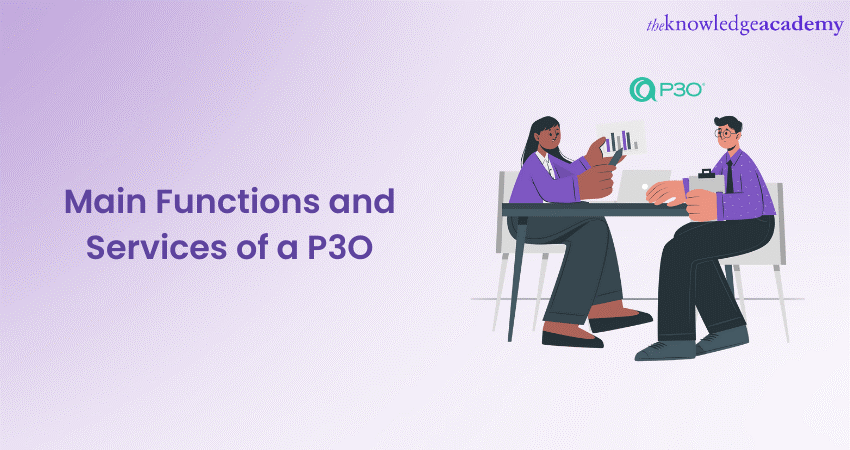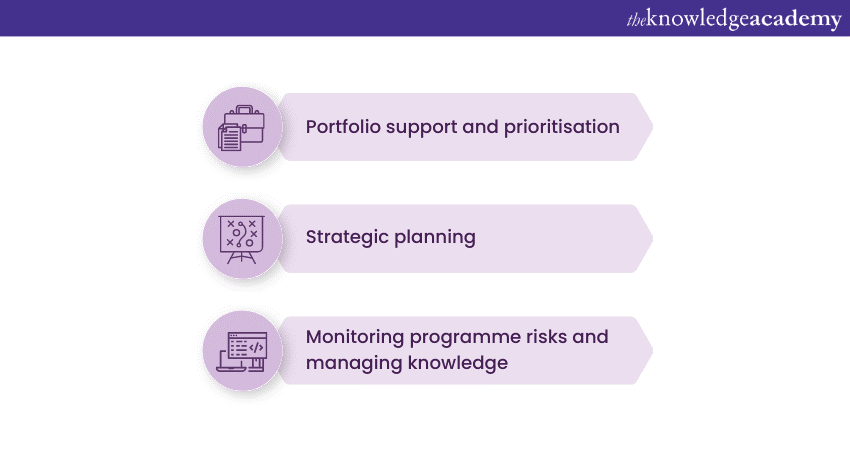We may not have the course you’re looking for. If you enquire or give us a call on 01344203999 and speak to our training experts, we may still be able to help with your training requirements.
Training Outcomes Within Your Budget!
We ensure quality, budget-alignment, and timely delivery by our expert instructors.

The Main Functions and Services of a P3O (Project, Program, and Portfolio Office) are essential for effective project, programme, and portfolio management within organisations. The P3O is a central hub, providing support, governance, and strategic alignment.
The P3O model emphasises driving efficiency, maximising benefits, and aligning initiatives with organisational goals. Read this blog to understand the Main Functions and Services of a P3O, its components, and key functions and services such as portfolio support, strategic planning, and programme monitoring.
Table of Contents
1) A system of organisational design for P3O: Hub and Spoke model
a) Components of the model
2) Main Functions and Services of a P3O
a) Portfolio support and prioritisation
b) Strategic planning
c) Monitoring programme risks and managing knowledge
3) Conclusion
A centralised system for P3O: The Hub and Spoke model
Organisations often face challenges such as redundant processes, lack of coordination, and fragmented decision-making are often encountered in complex project environments. The 'Hub and Spoke model' comes into play to address these concerns.
The model is a wheel where the central point or 'hub' is a fixed location from which paths protrude outward. It offers a centralised approach to project, program, and portfolio management, enabling efficient communication, collaboration, and control across different levels of the organisation.

Components of the model
The centralised Hub and Spoke model comprise two main components. They have been discussed as follows:
1) The Hub: It represents the central decision-making body within the P3O structure. It provides oversight, defines governance policies, allocates resources, and ensures alignment with organisational objectives.
The Hub also facilitates communication and collaboration between the spokes, enabling the exchange of best practices, lessons learned, and resource optimisation. It encompasses some key responsibilities such as:
a) Strategic decision-making
b) Governance and oversight
c) Resource allocation
d) Communication and collaboration
e) Capacity building and support
2) The Spokes: The P3O Model represents an individual project or program team that operates under the guidance and governance of the central Hub. They play a vital role in executing the tactical aspects of Project Management, working towards achieving project objectives and contributing to the overall organisational goals. Like the Hub, the Spokes also encompass some key responsibilities, such as:
a) Project execution
b) Task implementation
c) Resource utilisation
d) Risk management
e) Communication and reporting
f) Learning and improvement
Stay ahead in the ever-evolving world of Portfolio, Programme, and Project Management. Renew your P3O certification through our comprehensive P3O® Re-Registration course.
Main Functions and Services of a P3O

We discuss the Main Functions and Services of a P3O in the following sections:
1) Portfolio support and prioritisation
Portfolio support and prioritisation are crucial functions of a P3O that help organisations make informed decisions about their Project and Program investments. Here's an overview of these points:
Portfolio Support:
a) Portfolio governance: This model provides governance structures and frameworks to ensure consistent decision-making across the Portfolio. It establishes clear roles and responsibilities, defines project selection criteria, and monitors Portfolio performance.
b) Resource allocation: This model assists in resource allocation, ensuring that the right resources are assigned to Projects and Programs based on strategic priorities. It helps balance resource demand and availability, optimising resource utilisation across the Portfolio.
c) Benefits realisation: This model supports identifying, tracking, and realising benefits from Projects and Programs within the Portfolio. It establishes mechanisms to monitor and measure benefits, ensuring they align with the organisation's strategic objectives.
Prioritisation:
a) Strategic alignment: This model ensures that Project and Program investments align with the organisation's strategic goals. It assesses projects based on their potential contributions to strategic objectives, prioritising those that offer the highest value and strategic alignment.
b) Risk assessment: This model conducts risk assessments for Projects and Programs within the Portfolio, identifying potential risks and their impacts on strategic targets. It helps prioritise projects to mitigate risks and ensure the achievement of strategic objectives.
c) Resource and financial constraints: This model considers resource and financial constraints when prioritising projects. It considers factors such as resource availability, budget limitations, and dependencies to determine the order of project execution.
Supercharge your career in Portfolio, Programme, and Project Management with P3O® Foundation & Practitioner course.
2) Strategic planning
Strategic planning is an essential function of a P3O as it ensures that Project and Program activities align with the organisation's long-term vision. Here's a closer look at strategic planning within a P3O:
a) Setting objectives: This model assists in defining strategic objectives, working closely with senior management and stakeholders to understand the organisation's vision and goals. It helps translate these objectives into actionable plans and initiatives.
b) Roadmap development: This model helps develop a strategic roadmap that outlines the sequence of Projects and Programs required to achieve the organisation's strategic objectives. It considers dependencies, resource availability, and potential risks to create a realistic and achievable plan.
c) Performance measurement: This model establishes Key Performance Indicators (KPIs) and metrics to measure the progress and success of strategic initiatives. It monitors performance against strategic goals, identifies gaps, and recommends corrective actions to keep the organisation on track.
Design, implement, and work with a P3O model, by signing up for the P3O Practitioner Training Course now!
3) Monitoring programme risks and managing knowledge
Effective risk and knowledge management are vital for successful Program Management. Here's an overview of these points within a P3O:
a) Risk monitoring: This model continuously monitors program risks, identifies, assesses and manages risks effectively. It establishes risk management processes, tracks risk mitigation activities, and provides timely reporting on risk status to Program Managers and stakeholders.
b) Knowledge capture: This model facilitates capturing, documenting, and sharing knowledge and best practices across Projects and Programs. It establishes knowledge management systems, encourages knowledge sharing, and provides access to lessons learned, case studies, and templates.
c) Lessons learned: This model conducts lessons learned sessions at the Program level to identify successes, challenges, and areas for improvement. It captures valuable insights from Program experiences and disseminates this knowledge to inform future decision-making and enhance Program delivery.
d) Continuous improvement: This model promotes a culture of continuous improvement by analysing program performance, identifying bottlenecks, and recommending process enhancements. It encourages feedback loops and supports the implementation of corrective actions to drive program excellence.
Acquire the knowledge to operate on a P3O project, by signing up for the P3O Foundation Training Course now!
Conclusion
The Main Functions and Services of a P3O are crucial for effective Project, Programme, and Portfolio management within organisations. The management model is pivotal in strategic alignment, governance, resource allocation, risk management, knowledge management, and continuous improvement. The benefits of P3O such as foster collaboration, efficiency, and strategic alignment, contributing to the overall success of Projects and Programs.
Make better informed decisions for your business processes, by signing up for the P3O Training Courses now!
Frequently Asked Questions
Upcoming Project Management Resources Batches & Dates
Date
 P3O® Foundation & Practitioner
P3O® Foundation & Practitioner
Mon 10th Jun 2024
Mon 8th Jul 2024
Mon 5th Aug 2024
Mon 2nd Sep 2024
Mon 7th Oct 2024
Mon 4th Nov 2024
Mon 2nd Dec 2024
Mon 6th Jan 2025
Mon 3rd Feb 2025
Mon 3rd Mar 2025
Mon 7th Apr 2025
Tue 6th May 2025
Mon 2nd Jun 2025
Mon 7th Jul 2025
Mon 4th Aug 2025
Mon 1st Sep 2025
Mon 6th Oct 2025
Mon 3rd Nov 2025
Mon 1st Dec 2025







 Top Rated Course
Top Rated Course


 If you wish to make any changes to your course, please
If you wish to make any changes to your course, please


